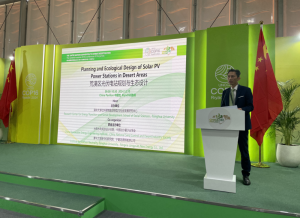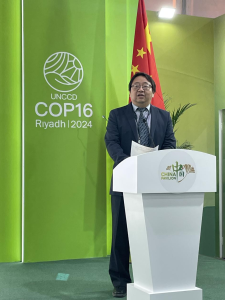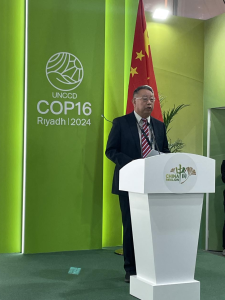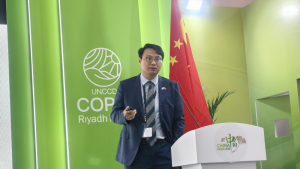On the morning of December 10, the side event titled “Planning and Ecological Design of Solar PV Power Stations in Desert Areas” was held at the China Pavilion of the 16th session of the Conference of the Parties (COP16) to the United Nations Convention to Combat Desertification (UNCCD) in Riyadh. This side event was organized by the Research Center for Energy Transition and Social Development, School of Social Sciences, Tsinghua University, in collaboration with China Renewable Energy Engineering Institute, China National Sand Control and Desert Industry Society, Institute for Carbon Neutrality, Tsinghua University, Ningxia Longyuan New Energy Co., Ltd.
This side event aims to discuss in depth the latest research results, practical experience and innovative ideas on photovoltaic and land desertification control, promote the application of new energy in global land desertification control, and release an initiative on photovoltaic power stations to promote desertification control.
 Those who spoke at the side event include Pradeep Monga, former Deputy Executive Secretary of the UNCCD. Guo Yufu, member of the UNCCD Science and Technology Committee, Pan Bing, Senior Inspector of the State Forestry and Grassland Administration,Ma Honghai, Mayor of Zhongwei City; Yang Wenbin, Executive Vice President and Secretary General of China National Sand Control and Desert Industry Society, Wang Weiying from China Renewable Energy Engineering Institute, and Liu Tianping, Director of Ningxia Zhongwei Forestry and Grassland Bureau.
Those who spoke at the side event include Pradeep Monga, former Deputy Executive Secretary of the UNCCD. Guo Yufu, member of the UNCCD Science and Technology Committee, Pan Bing, Senior Inspector of the State Forestry and Grassland Administration,Ma Honghai, Mayor of Zhongwei City; Yang Wenbin, Executive Vice President and Secretary General of China National Sand Control and Desert Industry Society, Wang Weiying from China Renewable Energy Engineering Institute, and Liu Tianping, Director of Ningxia Zhongwei Forestry and Grassland Bureau.
Additionally, Ai Jincai, Chairman of Ningxia Longyuan Renewable Energy Company, Yu Yi, PhD and Professor, INNER MONGOLIA IMBRICATION S&T CO.,LTD, Jiang Hao, Chief Technical Expert and Director of the International Marketing Department, China Renewable Energy Engineering Institute, Chen Siyu, Executive Director of Overseas Services, IT Electronics Eleventh Design & Research Institute Scientific and Technological Engineering Corporation, and Kan Cheng, Chief Bid Director of POWERCHINA Saudi Arabia, attended the conference and delivered speeches.
The first half of the conference was hosted by Jiang Hao, Director of International Marketing Department of China Renewable Energy Engineering Institute.

Mr. Pradeep Monga, former Deputy Executive Secretary of the UNCCD
In a video speech at the meeting, Mr. Pradeep Monga, former Deputy Executive Secretary of the UNCCD, proposed to promote and apply the “Land-PV plus” model in China to support China’s dual-carbon goals and the global transition to renewable energy. He emphasized that in terms of the “Land-PV plus” model and renewable energy development, going alone allows you to go fast while going together allows you to go far.”

Guo Yufu from the UNCCD Science and Technology Committee
Guo Yufu from the UNCCD Science and Technology Committee stated that achieving Land Degradation Neutrality (LDN) by 2030 is a core objective of the UNCCD. China is a pioneer in achieving LDN globally, pioneering a path with Chinese characteristics to address desertification and enhance green coverage. By combining LDN with the development of wind and PV energy projects, China has demonstrated how solar power station contributes to desertification control.
 Pan Bing, Senior Inspector of National Forestry and Grassland Administration
Pan Bing, Senior Inspector of National Forestry and Grassland Administration
Pan Bing, Senior Inspector of National Forestry and Grassland Administration, pointed out that based on preliminary estimates for a 450-gigawatt clean energy base as planned by the country, 12 million mu (a unit of area in China) of sandy, Gobi, and desert land will be used by 2030. The planning document clearly states that these large-scale wind and PV bases must be ecologically friendly and economically superior. However, there are still many scientific, technical, engineering, and management issues to be resolved regarding the coordination of PV and ecology. This is an inter-industry issue.
“This conference demonstrates the active posture and strong capability of local governments in participating in international ecological governance. It is also hoped that more government agencies and large energy enterprises can demonstrate China’s role as a participant, contributor, and leader in global ecological civilization construction by practical actions, actively participating in international ecological governance,” he said.

Ma Honghai, Mayor of Zhongwei City
Ma Honghai, Mayor of Zhongwei City, briefly introduced the path and achievements of Zhongwei City in “using PV to control desertification.” In recent years, Zhongwei City has witnessed vigorous development in desert tourism, desert agriculture, and the desert PV industry, gradually blazing a new path for development that complements ecological, social, and economic benefits. Zhongwei’s effective practices and successful experiences in combating desertification attract tens of thousands of experts and scholars from around the world to inspect and learn every year, showcasing to the world the “Chinese solution” and “Zhongwei model” for desertification control.
Zhongwei City firmly implements the important instructions of General Secretary Xi Jinping, led by three typical models: “PV + grassland,” “PV + shrub forest land,” and “PV + desert control,” and uses the “Ningxia-Hunan DC” transmission channel to introduce 11 enterprises such as Longyuan and Guodian to build a “sandy, Gobi, and desert” new energy industrial base. It has constructed an ecological governance system for the farming-pastoral featuring “power generation on the panels, ecological restoration under the panels, and planting between the panels,” providing scientific support and practical evidence for the sustainable and healthy development of the PV industry.
 Yang Wenbin, Executive Vice President and Secretary General, China National Sand Control and Desert Industry Society
Yang Wenbin, Executive Vice President and Secretary General, China National Sand Control and Desert Industry Society
Yang Wenbin, Executive Vice President and Secretary General, China National Sand Control and Desert Industry Society, said in his speech that installing 50 kW of PV on one mu of land can generate up to 10,000 kWh of electricity in areas with good sunlight resources such as Jiuquan, with an income of approximately RMB 3,000. This allows desert, Gobi, and desert areas with extremely low productivity to create hundreds to thousands of times more production through PV. In recent years, China’s efforts to use PV to control desertification have achieved great success in Ningxia, Erdos, and other regions, which earned enthusiastic praise from leaders at this conference. Today’s side event is not only a milestone for China’s PV desert control efforts but also an important milestone for global PV desert control efforts.
Subsequently, the launch ceremony for the Zhongwei PV Ecological Collaborative Innovation Demonstration Base was held, and 10 experts from Tsinghua University, the China Society of Desertification Control, the Chinese Academy of Forestry, and the Chinese Academy of Sciences received expert committee appointment letters for the Zhongwei PV Ecological Collaborative Innovation Demonstration Base.

 Wang Weiying from the China Renewable Energy Engineering Institute
Wang Weiying from the China Renewable Energy Engineering Institute
Wang Weiying from the China Renewable Energy Engineering Institute provided a brief overview on the topic of “Synergized Development of New Energy and Ecology in China’s Desert Areas.” He pointed out that the “agriculture-PV complementarity,” “forestry-PV complementarity,” and “pastoral-PV complementarity” models in China’s desert renewable energy bases have formed a virtuous cycle of industry and ecology. A comprehensive sand control solution featuring solar PV power generation technology, supplemented by vegetation cover, sand barrier fixation, land reclamation, and eco-tourism development, offers high economic and social benefits.
However, in his view, it is necessary to conduct scientific and technological research on the climate, soil, water sources, vegetation types, and layout of PV panels in the project area to realize large-scale solar power development. Based on the rational use of land resources, with sandstorm control as the core, optimize the windbreak and sand-fixing design of PV modules and arrays, and adopt measures such as laying sand barriers, improving soil, and planting vegetation to achieve optimal ecological governance effects and form an ecological governance model most suitable for PV project.

Liu Tianping, director of Ningxia Zhongwei Forestry and Grassland Bureau
Liu Tianping, director of Ningxia Zhongwei Forestry and Grassland Bureau, introduced the desertification control efforts in Zhongwei City. “Firstly, we accelerate engineering governance and conscientiously implement the desertification prevention and sand control planning in Zhongwei City and carry out ecological protection and restoration projects such as sand fixation and border locking at the southeastern edge of the Tengger Desert, sandification land treatment in Xiangshan, development of characteristic sand industries, and construction of riparian forests along the Yellow River, with the aim of completing the treatment of 2.25 million mu of sandified land by 2027.
“Secondly, we innovate PV technology for desert control. We accelerate the construction of the 6GW PV power station project in the Tengger Desert, invite research institutions and central enterprises such as Tsinghua University, the Chinese Academy of Sciences, and the China Renewable Energy Engineering Institute, and organize top international and domestic energy and ecological experts to provide academic support for PV ecological collaborative innovation. We will carry out scientific research, technical demonstration, and management innovation in aspects such as the full lifecycle ecological design, ecological governance, and ecological benefit assessment of desert PV power stations, aiming to create an international benchmark for the coordination of PV and desertification control,” he said.
Thirdly, we strengthen foreign exchange and cooperation. The 6GW PV power station project in the Tengger Desert has become a research partner of Tsinghua University in desertification control. We hope that more international representatives and desertification control experts will come to Zhongwei to provide guidance and share sand control technologies and PV ecological collaborative innovation achievements.”

Ai Jincai, Chairman of Ningxia Longyuan Renewable Energy Company
Ai Jincai, Chairman of Ningxia Longyuan Renewable Energy Company, introduced the PV desert control design and ecological benefits of Longyuan Ningxia Company’s PV base in the Tengger Desert and shared via video the development of the base in terms of PV desert control technology, industrial integration, and ecological improvement.

Yu Yi, Ph.D, Professor, INNER MONGOLIA IMBRICATION S&T CO.,LTD
Yu Yi, Ph.D, Professor, INNER MONGOLIA IMBRICATION S&T CO.,LTD, introduced the advantages of green and low-carbon sand control model, biodegradable sand barrier technology and industrial technology for desertification control. He stated that the green low-carbon sand control model integrates biodegradable sand barrier technology with the concept of near-natural vegetation restoration. The biodegradable sand barriers maintain their protective effect for 8 to 10 years and reduce the average cost by approximately 50%. The biodegradable sandbag barrier technology for desertification control boasts the advantage of using sand to control sand without transportation. Additionally, the production of polylactic acid fiber products reduces CO2 emissions by 2.8 times compared to chemical fibers. Industrial sand control can reduce handling volumes by 20 to 60 times and increase the speed of desertification control by 3 to 5 times through continuous laying methods.
The second half of the conference was hosted by Dr. He Jijiang, Executive Deputy Director of the Center for Energy Transition and Social Development Research at the School of Social Sciences, Tsinghua University.
 Jiang Hao, Chief Technical Expert, Director of International Marketing Department, China Renewable Energy Engineering Institute
Jiang Hao, Chief Technical Expert, Director of International Marketing Department, China Renewable Energy Engineering Institute
Jiang Hao, Chief Technical Expert, Director of International Marketing Department, China Renewable Energy Engineering Institute, introduced the current situation and prospects of China’s renewable energy development. Jiang Hao said that China-Arab renewable energy cooperation should be carried out from three aspects. First, strengthen the cooperation and mutual trust between Chinese and Arab enterprises, give full play to China’s manufacturing capacity and industrial chain advantages, and strengthen pragmatic cooperation with the Arab League in cutting-edge technologies and emerging industries. Second, establish the concept of large-scale development and enhance the overall capabilities of China and Arab countries in the field of renewable energy. Third, actively explore new models of renewable energy cooperation, give play to the advantages of organizations such as the International Renewable Energy Agency, share technical experience and carry out joint research and development through large-scale international exchange activities, strengthen cooperation in wind energy, solar energy, energy storage and hydrogen energy, and promote China-Arab energy transformation and sustainable development.
 Chen Siyu, Executive Director of Overseas Services, IT Electronics Eleventh Design & Research Institute Scientific and Technological Engineering Corporation
Chen Siyu, Executive Director of Overseas Services, IT Electronics Eleventh Design & Research Institute Scientific and Technological Engineering Corporation
Chen Siyu, EExecutive Director of Overseas Services, IT Electronics Eleventh Design & Research Institute Scientific and Technological Engineering Corporation, focused on introducing the photovoltaic tree invented by Eleven Technology Innovation. According to Chen Siyu, the photovoltaic tree is a green energy technology tree that converts solar energy into electrical energy, making it possible for solar energy to benefit the lives of thousands of households. It has dozens of patents and has won the International Contribution Award of the World Green Design Organization. The photovoltaic tree is very flexible to arrange and can be arranged in front of and behind houses, in courtyards, on both sides of roads, parks and other places.
 Kan Cheng, Chief Bid Director of POWERCHINA Saudi Arabia
Kan Cheng, Chief Bid Director of POWERCHINA Saudi Arabia
Mr. Kan Cheng, Chief Bid Director of POWERCHINA Saudi Arabia, gave a report on “Sharing the Practical Experience of China Power Construction Overseas Photovoltaic Project Construction”, showing the audience the main precautions, ecological protection, technological development and practical results in the construction of overseas photovoltaic projects.
Finally, at the launch ceremony of the cooperation platform, Zhongwei Longyuan Power Tengger Desert Photovoltaic Base will become a research partner of Tsinghua University-UNCCD REPER Cooperation Platform.







